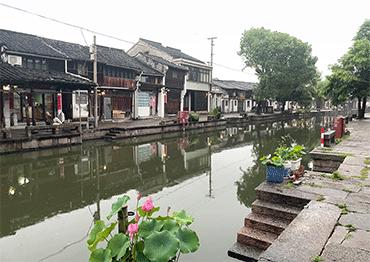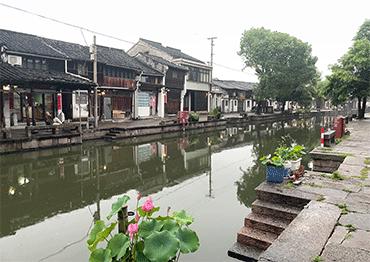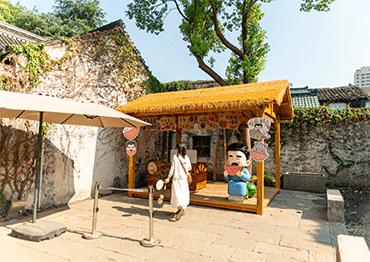If most people think of a color associated with China, they would probably say red. But there’s an argument to be made that it is yellow. The mythical first emperor was the Yellow Emperor.
Chinese civilization grew up around the Yellow River. However, there is another yellow deserves a spot in that pantheon – yellow wine, or huangjiu. And if you want to get to know this tipple better, there’s no finer place to do it than Shaoxing in Zhejiang Province, just south of Shanghai in the Yangtze River Delta, an area known as Jiangnan.
Yellow wine is thought to have emerged in China 3,000 years ago, around the Spring and Autumn Period (770-221 BCE), and it’s since been drunk by emperors, literati and the common people. Shaoxing has long been famous for its yellow wine, apparently due to the pure water used to make it, sourced from the city’s Mirror Lake.
The amber wine is usually fermented from rice, has a mild and slightly sweet taste with notes of fruitiness. It’s normally around 15 percent alcohol, but that can vary based on how long it’s brewed. To a Western drinker, it may bring to mind sherry, the wine often suggested as a substitute for “Shaoxing wine” in foreign cookbooks.
Among several prominent local producers, Nǚ Ér Hong, or “daughter’s red,” has an interesting origin story. There is a tradition in Shaoxing that when a girl is born, a jar of wine is brewed and stored underground on the day of her birth, and only dug out and opened on her wedding day. This is thought to be the best length of time to brew a batch of yellow wine.
To get the lowdown on the city’s ancient wine culture, as well as a decent buzz, head to the Shaoxing Yellow Wine Museum where you can explore the fermentation process, and enjoy wine tasting and making. Alternatively, if you come in the autumn, the city puts on an annual Shaoxing Yellow Wine Festival to experience all types of yellow wine and its culture. However, as yellow wine is also widely homebrewed, you can have an experience of grassroots culture throughout the city. Try getting a cab out to the city’s suburbs and eating at a village home-cum-restaurant – they’ll likely have a few clay pots filled with wine for you to sample. Some of them can be found in Xilu Village near Kuiji Mountain scenic spot in the city’s west.
Shaoxing boasts a rich “water town” culture, typical of the Jiangnan region. In a way, the whole city itself is a kind of water town, crisscrossed by countless waterways that make for a somewhat kinetic driving experience as you bounce up and down little bridges. In spots where traditional architecture has been preserved, wooden houses with lime-washed walls crowd around canals, threaded by the narrow, slate-paved streets. Most days, those alleyways are slicked by the rain and mist hangs over the rivers. This scene, along with copious volumes of yellow wine, inspired many scholars and artists during the Tang and Song dynasties (618-1279), making poetry, calligraphy and painting flourish.
However, Shaoxing’s old city part is usually crowded with tourists and gimmicky “internet-famous” shops, losing the authentic feeling of the old water town. The best place to get a sense of what the city once looked like now sits a bit outside of the city center. Anchang Ancient Town, in the northwest of Shaoxing County isn’t too commercialized yet. Locals still live and work there, so traditional houses and lifestyles remain. Its mile-long market street is along the north bank of the canal, opposite residences on the south bank. Small shops line the narrow stone street, decorated with traditional lanterns and with shop names carved onto wooden signboards, or embroidered on banners. Local specialties like meigan cai, or preserved mustard greens, which are usually added to stews, are piled in bags neatly lining on the ground. Above them hang preserved sausages, salted duck and air-dried pig trotters. The famous Shaoxing stinky tofu is impossible for your nose to miss. Skillful middle-aged men deep fry it quickly, and ask you to dip the crispy-outside, tender-inside tofu into a spicy or salty soybean sauce.
You can also rent a traditional black-awning boat, punted along a local and sway your way through the water town. When the sun sinks, shops start to close and women squat down to wash their clothes and mops in the river. Old men and women take their after-dinner strolls, perch on the benches that run along the street and ponder the tourists. You might spot a group of middle-aged women gathering in the small square to dance to ear-splitting electropop. If you ask any of them where to dine, they’ll send you down a small alley called Wangjia Lane, and suggest you order Shaoxing Three Delicacies, which is made of fresh meat balls, fish balls, shrimps and seasonal vegetables stewed in chicken soup.
Shaoxing’s most famous son is Lu Xun, perhaps China’s greatest modern writer. Working in the early 20th Century, he penned the first vernacular novel in Chinese history, and his satirical and acerbic writing, deeply concerned with the ills he saw plaguing Chinese society, influenced not only other writers but even political movements. He’s something of a mascot of the city now, and a cartoon version of Lu Xun, recognizable by his bushy moustache, can be seen on posters warning locals to be careful crossing the road, touting ice cream and on sale in stuffed form. What he’d write about this development is something we can only wonder about.
Much of Lu Xun’s writing was closely based on his own experiences, especially in Shaoxing. Real places and vignettes of local life suffuse his work. His former residences, including the Three-Taste School where he started his journey into literature, and the Hundred-Grass Garden where he played as a child are open to visitors.
Although the city has abundant historical relics, you can take a break with a little natural beauty too. Keyan Scenic Resort, eight kilometers west of the city, bears the intriguing scars of ancient quarrying. The same stone that drew the quarrymen also looms in strange caves and steep cliffs. The most striking view is the 20.8-meter-high Tiangong Big Buddha statue, made when quarries were still operating. Carved into a natural pillar in the middle of a small lake, it took three generations of masons to craft, starting in the Sui Dynasty (581-618) some 1,300 years ago.
Keyan is also a great place to hop on a boat and enjoy the waterways that winding through small woods to Jian Lake. On the lake, you will feel the peace that Shaoxing’s green hills and clear waters bring.

 Old Version
Old Version

